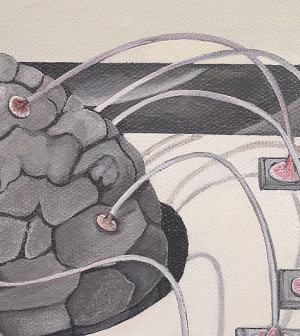- Navigating Your Midlife Crisis: Embracing New Possibilities
- City Raccoons Showing Signs of Domestication
- Mapping the Exposome: Science Broadens Focus to Environmental Disease Triggers
- One Week Less on Social Media Linked to Better Mental Health
- Your Brain Changes in Stages as You Age, Study Finds
- Some Suicide Victims Show No Typical Warning Signs, Study Finds
- ByHeart Formula Faces Lawsuits After Babies Sickened With Botulism
- Switch to Vegan Diet Could Cut Your Greenhouse Gas Emissions in Half
- Regular Bedtime Does Wonders for Blood Pressure
- Dining Alone Could Mean Worse Nutrition for Seniors
Even a Little Exercise May Help Stave Off Dementia

Couch potatoes have a higher risk of developing dementia in old age, a new study reports.
Seniors who get little to no exercise have a 50 percent greater risk of dementia compared with those who regularly take part in moderate or heavy amounts of physical activity, the researchers found.
Moderate physical activity can include walking briskly, bicycling slower than 10 miles an hour, ballroom dancing or gardening, according to the U.S. Centers for Disease Control and Prevention.
“It doesn’t require intensive physical activity to decrease risk of dementia,” said senior researcher Dr. Zaldy Tan. He is medical director of the Alzheimer’s and Dementia Care Program at University of California, Los Angeles. “Even moderate amounts are fine.”
Study participants aged 75 or older gained the most protective benefit from exercise against the onset of dementia, the findings showed.
“The message here is that you’re never too old to exercise and gain benefit from it,” Tan said. “These patients derive the most benefit from exercise because they are the ones who are at the age of greatest risk for dementia.”
Brain scans of participants showed those who exercise are better able to withstand the effects of aging on the brain, the study authors said.
With age, the brain tends to shrink. But people who regularly exercised tended to have larger brain volumes than those who were sedentary, Tan and his colleagues found.
The new study involved about 3,700 participants in the Framingham Heart Study, a federally funded health research project begun in 1948. All were 60 and older.
Researchers measured how often the participants exercised, and tracked them over a decade. During the study, 236 people developed dementia.
To see how physical activity might have affected dementia risk, the researchers broke the study population down into fifths that ranged from sedentary to highly active.
The one-fifth containing the most sedentary people were 50 percent more likely to develop dementia than the other four-fifths, the investigators found. In other words, even a little exercise helped.
The research team also compared physical activity to brain scans taken of about 2,000 study participants, and found a direct connection between exercise and brain size as people aged. Those who worked out had more total brain volume.
There are several theories why exercise might help brain health. Increased blood flow caused by physical activity might “beef up” the brain, increasing its volume and promoting the growth of additional neurons, said Dr. Malaz Boustani. He is research director of the Healthy Aging Brain Center at the Indiana University Center for Aging Research and a spokesman for the American Federation for Aging Research.
“Physical exercise might end up leading to increased density of the connections between the neurons and create alternative pathways for signals” that might otherwise be impeded due to age-related brain shrinkage, he added.
Boustani likened this process to a street system in a city. The more alternative routes are available to drivers, the less likely it is that a blockage on one street will lead to a city-wide traffic jam.
Exercise also promotes secretion of helpful brain chemicals such as brain-derived neurotrophic factor (BDNF). Tan explained that “BDNF actually encourages the growth of new neurons, and the preservation of those we already have.”
Heather Snyder, senior director of medical and scientific operations for the Alzheimer’s Association, said that the true answer is likely a combination of factors related to exercise.
“It’s likely there are multiple benefits, and they all funnel together,” Snyder said.
According to Boustani, these results support other studies that have shown an association between exercise and protection against dementia, but clinical trials aimed at proving a definite link have so far been disappointing.
“When we take it to the next step and start doing experiments, randomizing patients to physical exercise versus no physical exercise and see if that will protect their brain, the story becomes a little bit muddy and unclear,” he said.
Regardless, Boustani said he prescribes moderate intensity physical exercise to his patients as one way to preserve their brain health — 5,000 steps a day for about a month, increasing to 10,000 steps over time.
“Given that there’s no harm, and there’s a possible benefit to the brain that hasn’t been fully explained, I work with my patients and their families to help improve their physical activity,” he said.
The findings were published online recently in Journals of Gerontology: Medical Sciences.
More information
For more on physical activity intensity, visit the U.S. Centers for Disease Control and Prevention.
Source: HealthDay
Copyright © 2025 HealthDay. All rights reserved.










